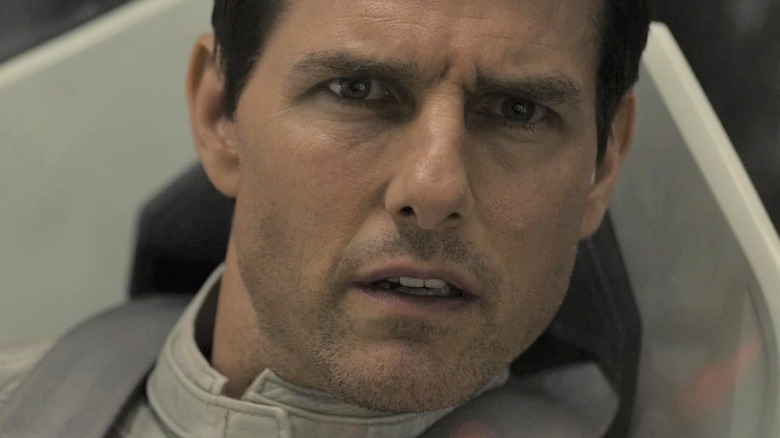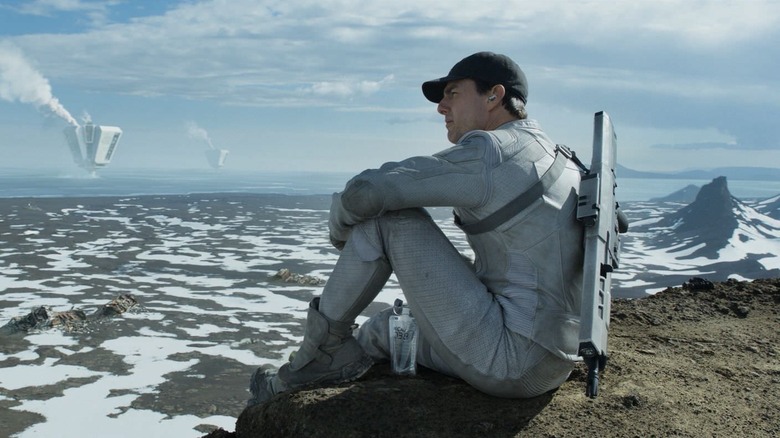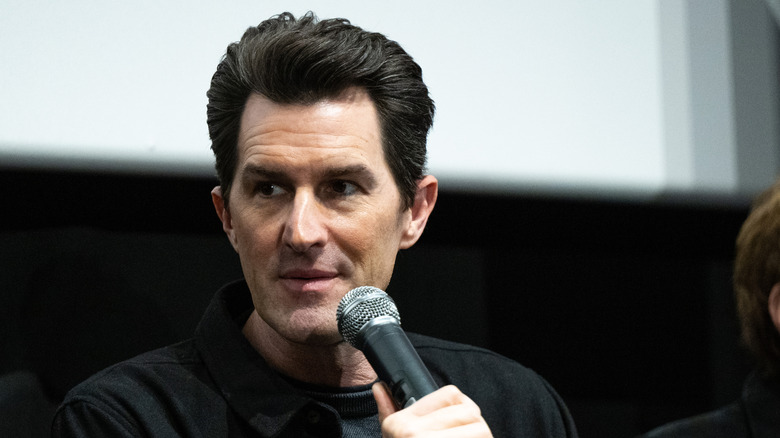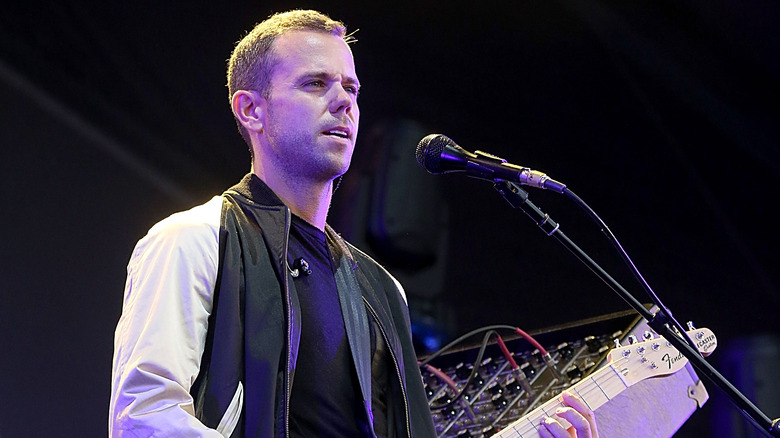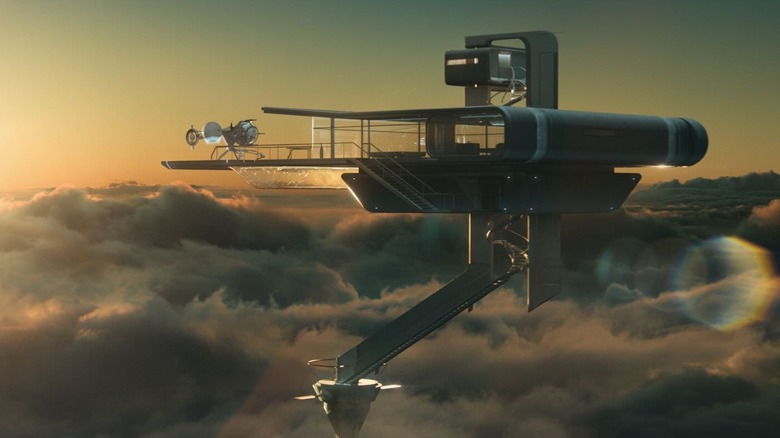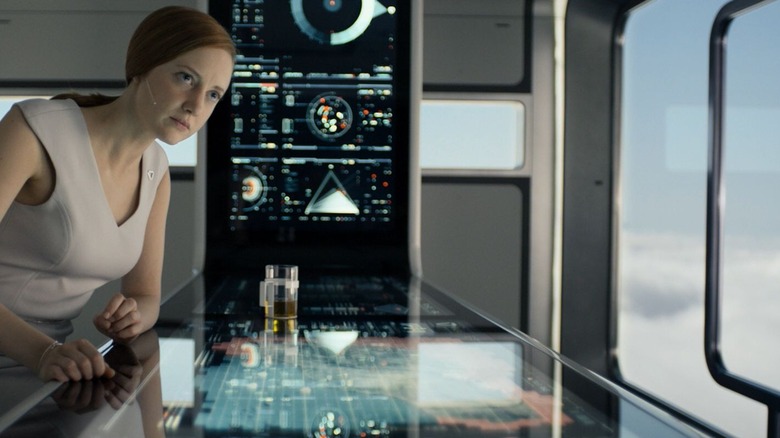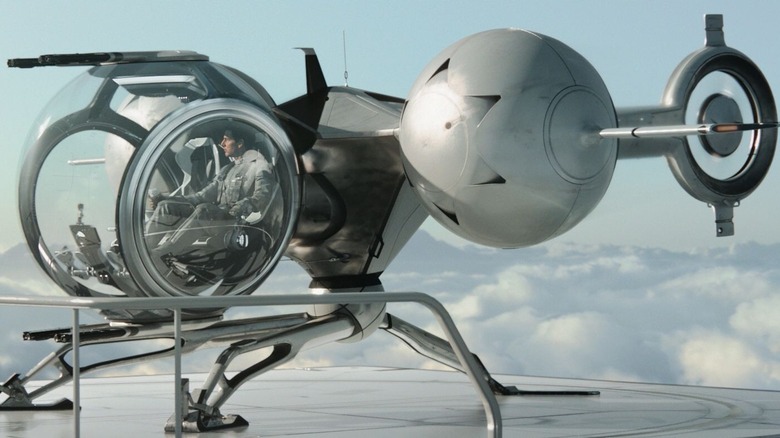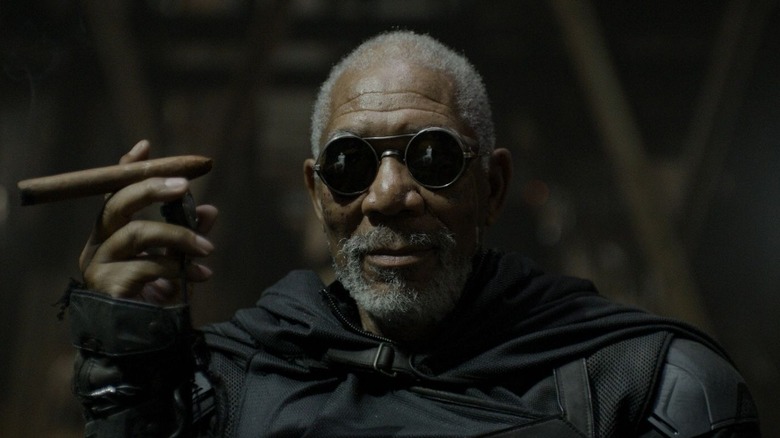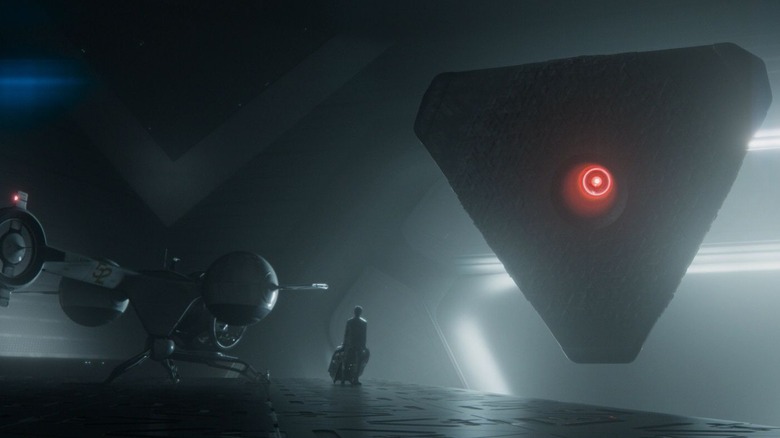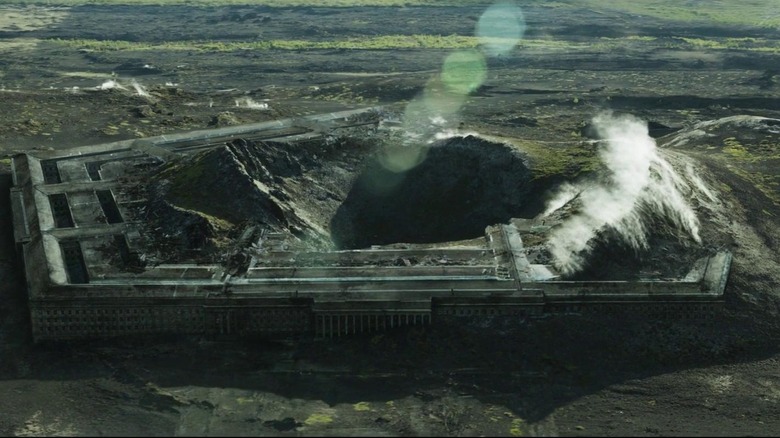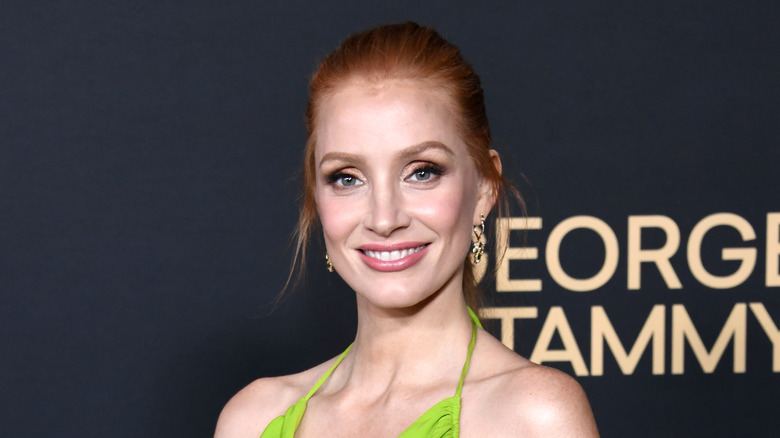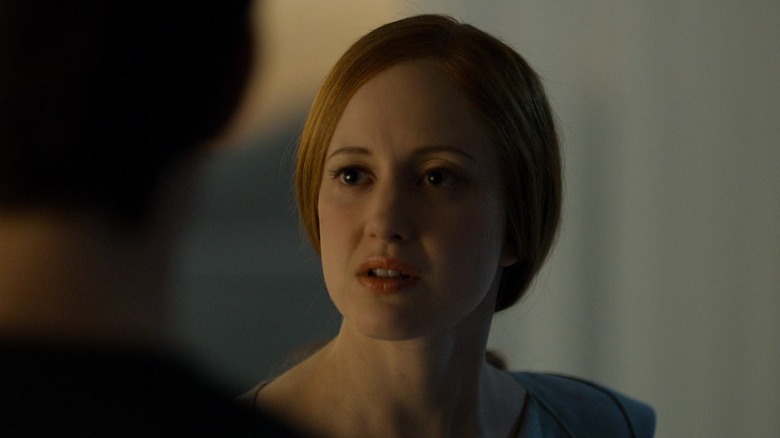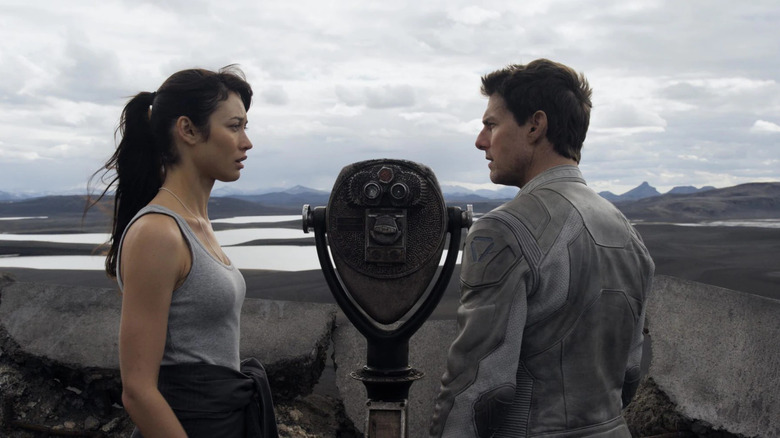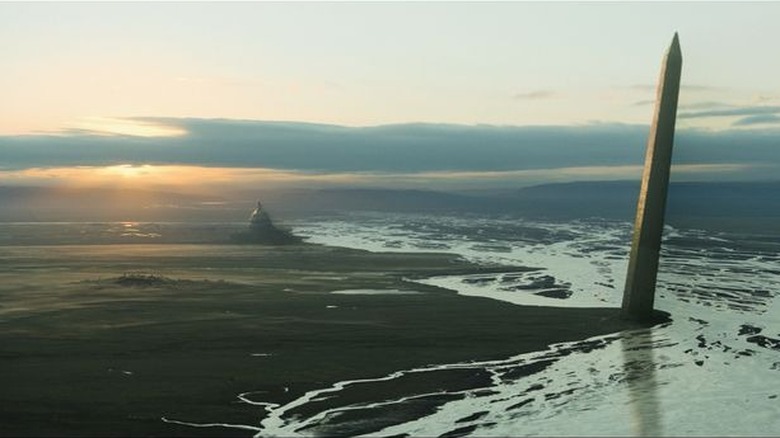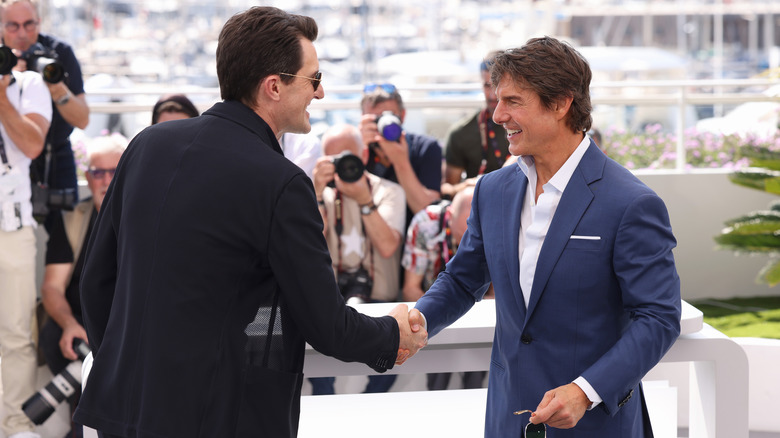Oblivion: 14 Facts About Tom Cruise's 2013 Hit Movie That Are Worth Extracting
Say what you want about Tom Cruise when it comes to anything else, but there is no denying that he has an uncanny ability to find and attach himself to incredibly interesting projects. The talented actor then often uses his star power to help the film become a hit, and "Oblivion," the actor's sci-fi epic from 2013, is no exception. Though Joseph Kosinski was far from an amateur after his work on 2010's "Tron: Legacy," the director was still fairly new, but especially after talking with him, Cruise had all the proof he needed that the production would be a success.
The movie seems rather straightforward at first, following the hero Jack Harper (Cruise) in a somewhat serene post-apocalyptic world after a devastating alien invasion. Though as the tale progresses, the world Jack thought he knew is not what it seems, revealing massive twists and a deeper story of love lost and found beneath it all while the protagonist becomes embroiled in a tense battle for the survival of humankind. Here's everything you didn't know about "Oblivion."
The story was first a graphic novel
When Joseph Kosinski was first developing the story for "Oblivion," the director had no idea it would become an epic sci-fi action flick starring one of Hollywood's top actors. So as he initially wrote it back in 2005, the scale was decreased significantly. In an interview with Collider, he said, "I thought it would be my first film, so I wrote it as a contained cast. The Sky Tower was going to be the main setting. It was always the story of drone repairman Jack Harper and his journey of redemption."
Then in 2007, Kosinski hit a major roadblock as he strove to get the film made when the Writers' Guild went on strike, which forced him to alter his approach and make the tale into a graphic novel. The filmmaker explained to Empire, "It couldn't be written by anyone in the guild so the partnership with Radical Comics allowed me to continue working on the story by developing a series of images and continuing to refine the story more over a period of years." The material created during this period worked great as a pitch for the movie, but unfortunately, fans of "Oblivion" and comics will never get to see a finished product — Kosinski was only ever really interested in making the film, and he achieved that goal.
The director wanted to bring sci-fi back into the daylight
While Joseph Kosinski was growing up during the 1960s and '70s, the sci-fi classics that he loved to watch were bright and often colorful, such as "2001: A Space Odyssey," "Planet of the Apes," and "Star Wars," so that older style was heavily influential to the distinctive look of "Oblivion." When talking with Collider, he explained, "It felt like in the [1980s], after 'Alien,' which is one of the greatest science fiction films of all time, science fiction went into a very dark place of deep space and dark ships, and I liked the idea of bringing science fiction back out into the daylight."
Additionally, Kosinski told /Film he was inspired by the vivid illustrations of artists from his childhood like Chris Foss and Peter Elson. The result is a fascinating spectacle on screen, with the bright aesthetic overlapping a grim storyline that takes place after a cataclysmic invasion. The director told Collider, "I thought we've seen so many dusty, gray, green-brown post-apocalyptic worlds. It'd be fun to see something with some color and daylight and brightness and this world above the clouds."
Oblivion was Anthony Gonzalez's first time composing a film score
Joseph Kosinski did not just strive to create a standout look for "Oblivion"; he also wanted an original soundtrack to match, and he knew exactly where to look. Electronic music star Anthony Gonzalez of M83 had never worked on a film before, but Kosinski knew he was the right person for the job and convinced him to take it on. As the director revealed to Collider, he literally listened to the group's music while developing the story, so it would have been difficult to accept a score written by anyone else.
Ultimately, Gonzalez was pleased with what he and his co-composer, Joseph Trapanese, were able to produce, but it did not come easy. When interviewed by Pitchfork, he admitted, "It took us one year to work on 'Oblivion' with Joseph Trapanese, and I've been through all types of emotions. I almost quit. I couldn't sleep. I was so stressed out. I was on the verge of breaking down. We were touring a lot and I had to work on this at the same time." But the biggest issues stemmed from what the studio expected from him, as he added, "They needed something bigger, more orchestral; it was hard for me to be told that my music was too indie for the film."
Joseph Kosinski used his engineering and architecture background
Before Joseph Kosinski became a filmmaker, he had rather different career goals, but the skills he attained during those pursuits were certainly nice to have when working on "Oblivion." The director told Collider, "My background is in mechanical engineering and industrial design. That's what I went to undergrad for, and then I went to architecture school for graduate school thinking I was going to be an architect. I was always looking for a career that could combine my creative interests with my technical side, and it ends up directing films is the perfect combination." To highlight how his extensive education was particularly useful for this film, Kosinski added, "The Bubbleship and the Sky Tower were two elements of the story that I had a very clear image of from the start."
Without a doubt, the most valuable of all was his vast experience working with 3D modeling software while working on his master's degree. The director not only described to BuzzFeed how the models of the signature Sky Tower were a solid base for the production design team to work with, but he also provided examples of the impressive early sketches as proof.
The film required considerably little CGI
Universal must have been pleased with Joseph Kosinski's ability to film a sci-fi epic like "Oblivion" with a significantly lower budget than other similar movies of the genre. For comparison, the director told /Film, "'Tron' had fifteen or sixteen hundred visual effects shots in it and 'Oblivion' is eight hundred shots, so it's almost half. Because I was able to do so much in camera. Hopefully it feels like a big movie, which is what I always wanted to do, but we did it."
The primary reason that Kosinski did not need to burn through as much cash as other productions was because of his clever use of front projection techniques, a method used previously by the renowned filmmaker Stanley Kubrick in "2001: A Space Odyssey." When talking with Film4, he and Tom Cruise explained how no blue screens were used in the background of the Sky Tower, and instead massive screens projected footage of cloud formations that were shot for weeks atop the peak of a Hawaiian volcano. The result was both a beautiful sight for audiences and a far more immersive experience for the actors as well.
3D was too dark to use
For Joseph Kosinski's first sci-fi flick, "Tron: Legacy," the filmmaker shot some sequences in 3D, and the film was ultimately released in 3D as well. The process was still riding the wave of "Avatar," released just a year before. Fully familiar with the format, the director did briefly consider going that route again for "Oblivion" but quickly realized it made no sense because of the aesthetic he was aiming to achieve.
The 4K format, on the other hand, was a much better option for one key reason. Kosinski explained to Collider, "The brightness levels of 3D right now are a fraction of what 2D is. With 2D, you're at 14 foot-lamberts, and with IMAX, you're at 22 foot-lamberts. But 3D films are at 4. So, the brightness isn't there and also your eyes react differently. At low level, they don't pick up color in the same way so you just don't get the saturation, and I knew I wanted this to be a daylight science fiction film."
Morgan Freeman took his role to work with Tom Cruise
Though Morgan Freeman was thoroughly impressed with the script for "Oblivion," he had to be honest and admit that it was Tom Cruise's involvement with the film that was the biggest selling point for him. Freeman was a longtime fan of the actor, and both men had wanted to work together since they first met in the 1990s, so it was bound to happen eventually.
For Freeman, it was important that the duo's first film was something special and not just any movie. He explained to Collider, "If that were the case, I would have been in 'Mission Impossible' 1, 2 or 3. But when the right project comes along, there's sort of a domino effect. Everything falls into place. I think this was the perfect genre for me to be involved with Tom in, so I no longer resent not having done anything with him before."
The film went from Disney to Universal
Initially, Disney was set to produce "Oblivion" because of Joseph Kosinski's great relationship with the studio, but it did not take long for problems to arise. The director told /Film, "With Disney, it was interesting, because I was doing 'Tron: Legacy' and I was under option to them. So they bought it and then as the project developed and I started building it, it became clear when I kept pitching these elements, that it didn't quite fit inside the Disney envelope and I think people who see the movie now, it makes sense."
Fortunately for the filmmaker, Disney was not the only major player interested in the movie. Universal was more than eager to step in, especially since then-chairman Adam Fogelson thought the screenplay was one of the most beautiful he has ever read. The transition from one studio to the next went very smoothly, not just because Disney was on good terms with Kosinski, but it also helped that his former producer, Sean Bailey, had become the president of the studio in 2010.
A panel of scientists were consulted for accuracy
While Joseph Kosinski did benefit greatly from his engineering and architecture background when designing several key elements of "Oblivion," he did not rely solely on his own expertise. The director told Film4, "I did consult with a panel of scientists at the beginning of the film just to kind of make sure that everything is rooted in science. The technology feels real."
The experts were brought on board not just to verify the accuracy of aspects he was more familiar with, like the Bubbleship, but more importantly, they were there to help figure out the effects of extreme changes to the global environment that occurred in the backstory. When talking with /Film, Kosinski said the panel was recruited to "discuss the geography, the climate, the change of what would happen to Earth if you destroyed the Moon and the changing of the tides." The director knew that such a catastrophic event would drastically alter the Earth, and could trigger all sorts of fallout disasters such as earthquakes, tsunamis, and super volcanoes, so their input was vital in showing the results of that chaos in the most realistic way.
Tom Cruise let Jessica Chastain leave the film
Before production on "Oblivion" began, there was a major change in the cast that was possible due to the kindness of Tom Cruise. Jessica Chastain looked forward to starring alongside the actor, but when she was offered a role in "Zero Dark Thirty," she quickly decided that was an opportunity that she just could not decline. In an interview with The Hollywood Reporter, she described how Cruise helped her out and explained, "Someone contacted him from my agency and said, 'Listen, she wants to work with you. And she would love to, but there is this other film, and it's so important.'"
Fortunately for Chastain, the request was not a problem for Cruise, and she was allowed to get out of her contract. The actress went on to add, "I really hope to find something in the future to do with him because I'm very grateful. [...] I've seen him afterwards. And I was like, 'Dude, you're awesome!'"
Andrea Riseborough was uncomfortable during filming
While many of the actors seemed to have enjoyed working on "Oblivion," that was not the case for all of the cast during filming. Andrea Riseborough admitted afterwards that even though she did not have a terrible time in the production, it was not pleasant overall. In an interview with Entertainment Weekly, the actress explained how the movie was shot far from home, which stirred up feelings of isolation since she only interacted with a few people at work most days. Plus, she also described the disorientation brought on by filming brightly lit, morning scenes well into the evening on the Sky Tower set.
Though the worst part of the production was the way Riseborough felt objectified during the shoot. In an interview with The A.V. Club, she said, "I think the thing I didn't enjoy about it ... was more on the studio side, the pressure to look a certain way. And I was never sure where it was coming from, but that was very important to people, how the women looked. That the women sort of looked attractive at all times." Performing with that in the back of her mind just made the experience feel awkward, as she added, "I don't really have the capacity to hold all of those things at once. Not in a way that I really like to work. And so I find that just detracted from... it just took up a lot of space and time."
The actors were attracted to the love story amidst the action
"Oblivion" may have stunning visuals, an intriguing plot, and scenes of intense action, but the love story underneath it all was another feature that helped draw more than one of the cast members to the project. When discussing the positive message of the movie, the first thing that Morgan Freeman told Collider was, "One of the themes that [stands] out in this film is the love story. It's not like one we've seen before."
The romance at its core was the one aspect that actress Olga Kurylenko, the love interest of Tom Cruise's character, liked the most about the film. When talking with Film4, she admitted, "['Oblivion'] was quite human, and it had a beautiful, romantic story, which is very important for me as a girl. It's fun when things blow up, but it's also nice to watch a love story."
Oblivion marked the first time Tom Cruise had ever been to Iceland
For a movie star who has traveled all over the world and filmed in numerous exotic locales, it would not be surprising if places are constantly being knocked off of Tom Cruise's bucket list. And this was certainly the case when filming began for "Oblivion," as he told Rotten Tomatoes Coming Soon, "I couldn't wait to go to Iceland. I've never been there. First of all, it's just [an] absolutely stunning country, and when you get there, it's hauntingly beautiful."
The breathtaking landscape was enough to spark awe in the actor, but the experience of being there was made even more special because of the brilliant way Joseph Kosinski used the environment to augment the look of the film. Cruise was already impressed with what the director had planned. But witnessing his vision in action on top of the incredible natural beauty exceeded his expectations.
Tom Cruise joined the project because of the director
When Tom Cruise met with Joseph Kosinski, he was highly impressed with the filmmaker's vision for "Oblivion" and its fascinating story, so the actor got involved very early on, before Universal picked it up and the script was even still in its draft stages. But Cruise was convinced the project would be a success, as he said in a Live Media Group Q&A, "He's a guy who's a world creator, a true visionary." On top of this praise, the actor added, "He wanted a haunting beauty, a very unique aesthetic for the film, and I think that that world that he created, these characters he created, was something that I wanted to be a part of."
With the backing of such a huge star, Kosinski was no longer as limited as he thought he would be a few years before. The director was then able to expand his initial idea and keep the parts he liked most about the tale, but tell it on a much grander scale. Cruise must have loved him as a collaborator, since the duo reunited a few films later for "Top Gun: Maverick." But it was that 2013 film, Kosinski's visually stunning "Oblivion," that first hooked Cruise.
